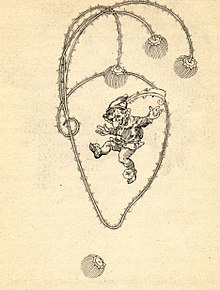
Back كوبولد Arabic Коболд Bulgarian কোবোল্ড Bengali/Bangla Kobold Czech Kobold German Koboldo Esperanto Kobold Spanish Kobold Basque کوبولد Persian Kobold French
 The kobold Heinzelmann | |
| Grouping | Mythological creature Fairy Sprite |
|---|---|
| Country | Germany |
A kobold (occasionally cobold) is a mythical sprite.
Earliest attestation from medieval writings (13th century) indicate it was a doll carved from wood or made of wax, and it is speculated these were fetish figurines, or carvings of household spirits, set up in the house, likely mounted upon the fireplace mantel or the hearth.
The practice may may have descended from an ancient Germanic house or a hearth god (Old High German: hûsing, herdgota), similar to the ancient Roman lares or lar (hearth goddess) worshiped as figurines, or the penas (sing. of penates).[1][4][5] The Eastern slang gütel or güttel "little god" ("little god"; possibly equivalent to götze) perhaps should by added as another kobold synonym, and may support the view of this sort of use.
What is clear is that these kobold dolls were puppets used in plays and by travelling showmen, based on 13th century writings. They were also known as tatrmann and described as manipulated by wires. Either way, the idol or puppet was invoked rhetorically in writing by the minstrels, etc. to mock clergymen or other people.[7]
The kobold in the general sense of "house spirit" is known by various other names. Kobold subtypes called hütchen or Low German hödekin come from their wearing caps or hoods. It has been stated by Jacob Grimm that the kobold has the general tendency to wear red pointy hats, while acknowledging this to be a widely disseminated mark of household spirits under other names such as the Norwegian nisse; and the North or Northeastern German Niss or Puk (cog. puck) are also prone to wearing such caps. The kobold subtypes katrmann and Hintzelmann suggest its occasional cat-form. The similar sounding Heinzelmann or Heinzelmännchen has been explained to be a distinguishable, separate being by later scholars. But the kobold is also known by other pet names such as Chimke (diminutive of Joachim). As household spirits, they may perform domestic chores, or play malicious tricks if insulted or neglected. In German folklore, the kobold materialize in the form of such an animal, a human, or a pillar of fire.
The original notion of the kobold as household spirit, seemingly corroborated by the etymology kob[en] "chamber" + walt "ruler, power, authority" was corrupted by the idea of mine spirits. Such mine spirits in the legends of 16th century German mine-workers were called kobel (cobalus) and Bergmännlein (virunculos montanos) as attested by Georgius Agricola (see gnome). Grimm had argued for an alternate etymology for kobold, as deriving from this Latin cobalus, making kobold a cognate of cobalus (kobel) and "goblin". Older literature spoke of stetewalden ("ruler of the place") which may be a precursor.
The Klabautermann aboard ships that help sailors are sometimes classed as a kobold.
The name of the element cobalt comes from the creature's name, because medieval miners blamed the sprite for the poisonous and troublesome nature of the typical arsenical ores of this metal (cobaltite and smaltite) which polluted other mined elements.
- ^ Grimm & Stallybrass tr. (1883), pp. 500, 501: "lar, lar familiares"; "small lars"; Grimm (1875), pp. 413–414
- ^ Cite error: The named reference
notkerwas invoked but never defined (see the help page). - ^ Grimm & Stallybrass tr. (1883), p. 500.
- ^ Old High German hûsing is glossed as Latin penates in Notker,[2] cited by Grimm.[3]
- ^ Cite error: The named reference
simrock1855was invoked but never defined (see the help page). - ^ Cite error: The named reference
Handwoerterbuch1974-koboldwas invoked but never defined (see the help page). - ^ The Handwörterbuch des deutschen Aberglaubens assigns kobold synonyms separately as A. doll names and B. names for deriding an imbecile, but comments that the A type names served as B type pejoratives.[6]
© MMXXIII Rich X Search. We shall prevail. All rights reserved. Rich X Search